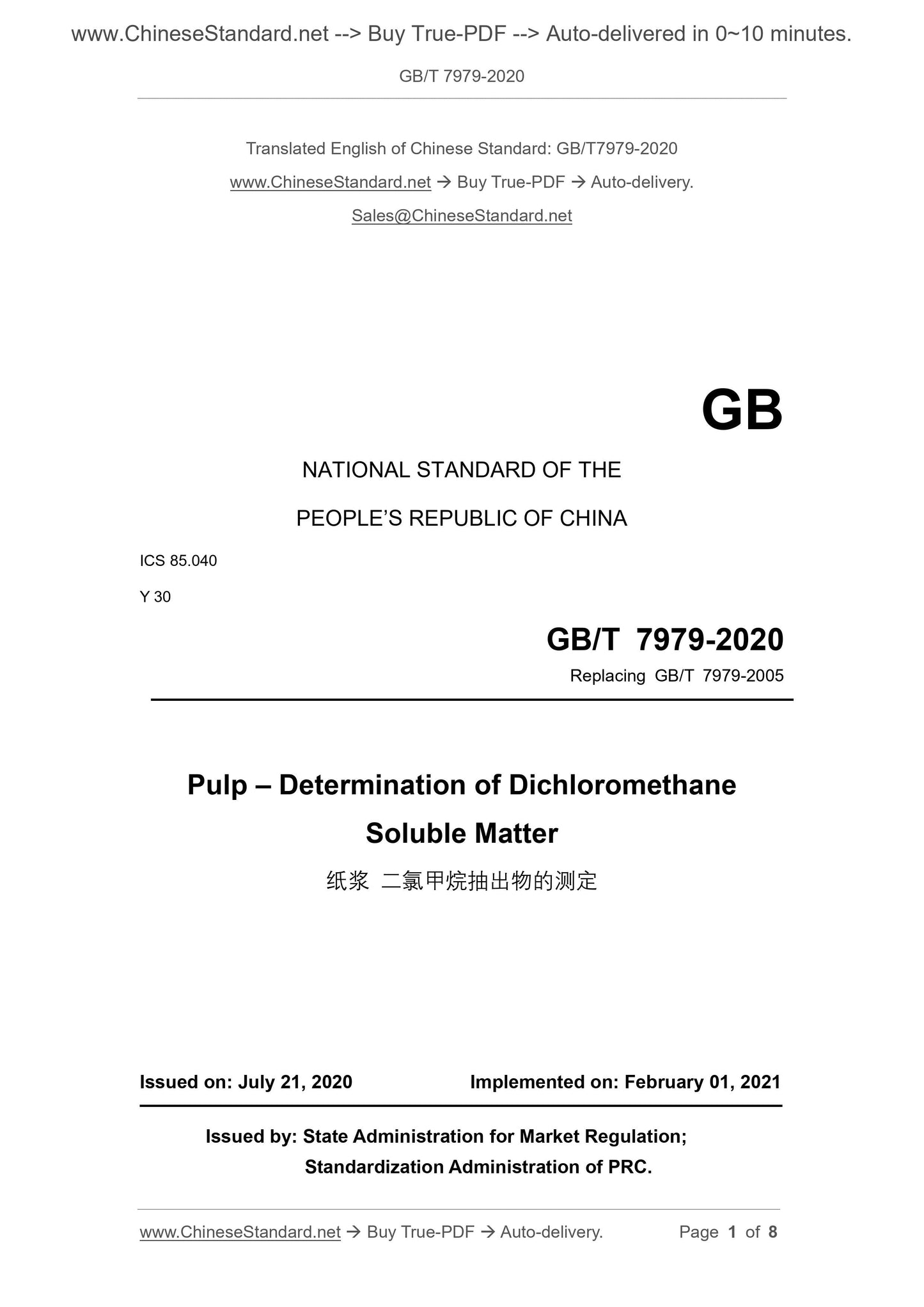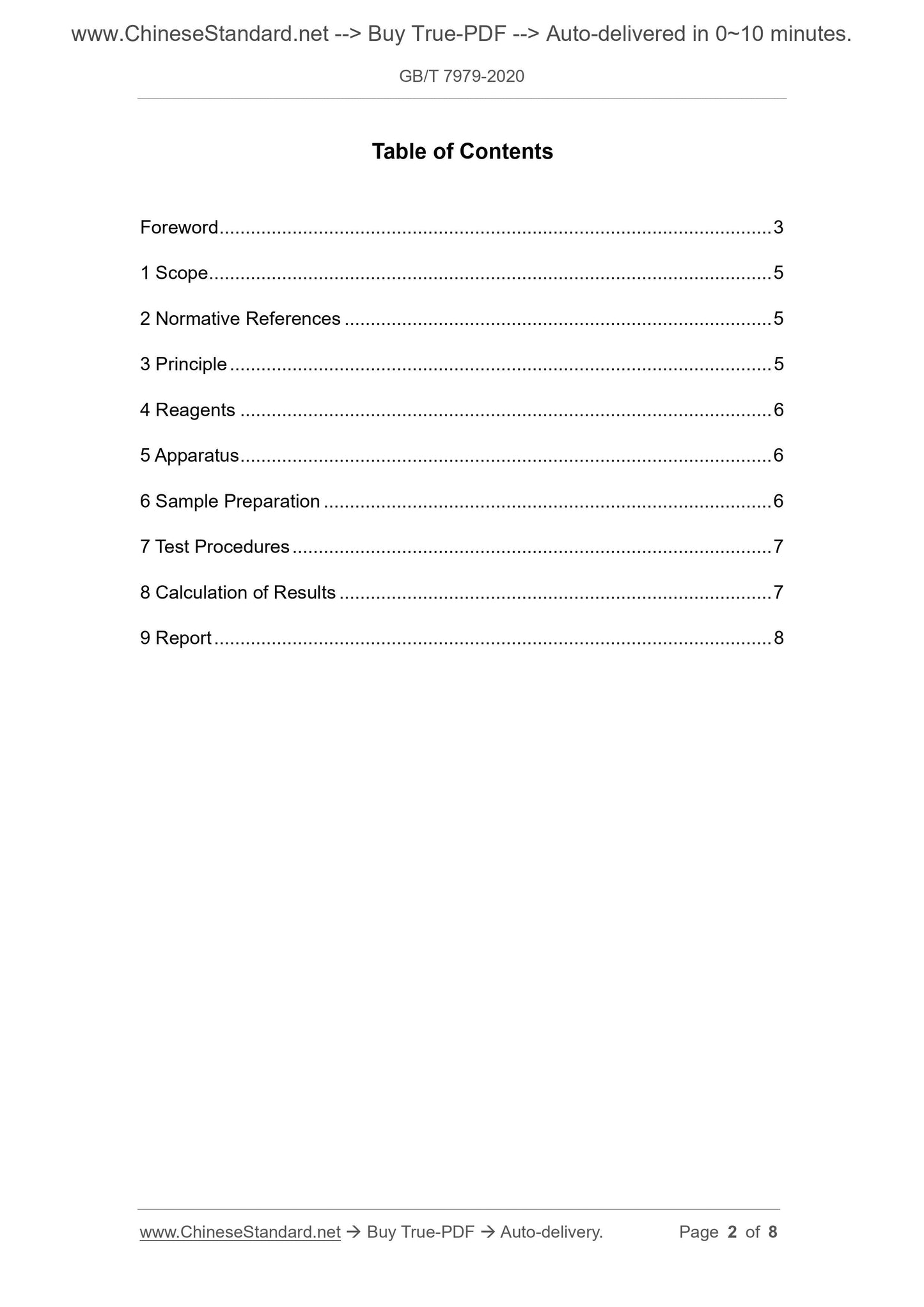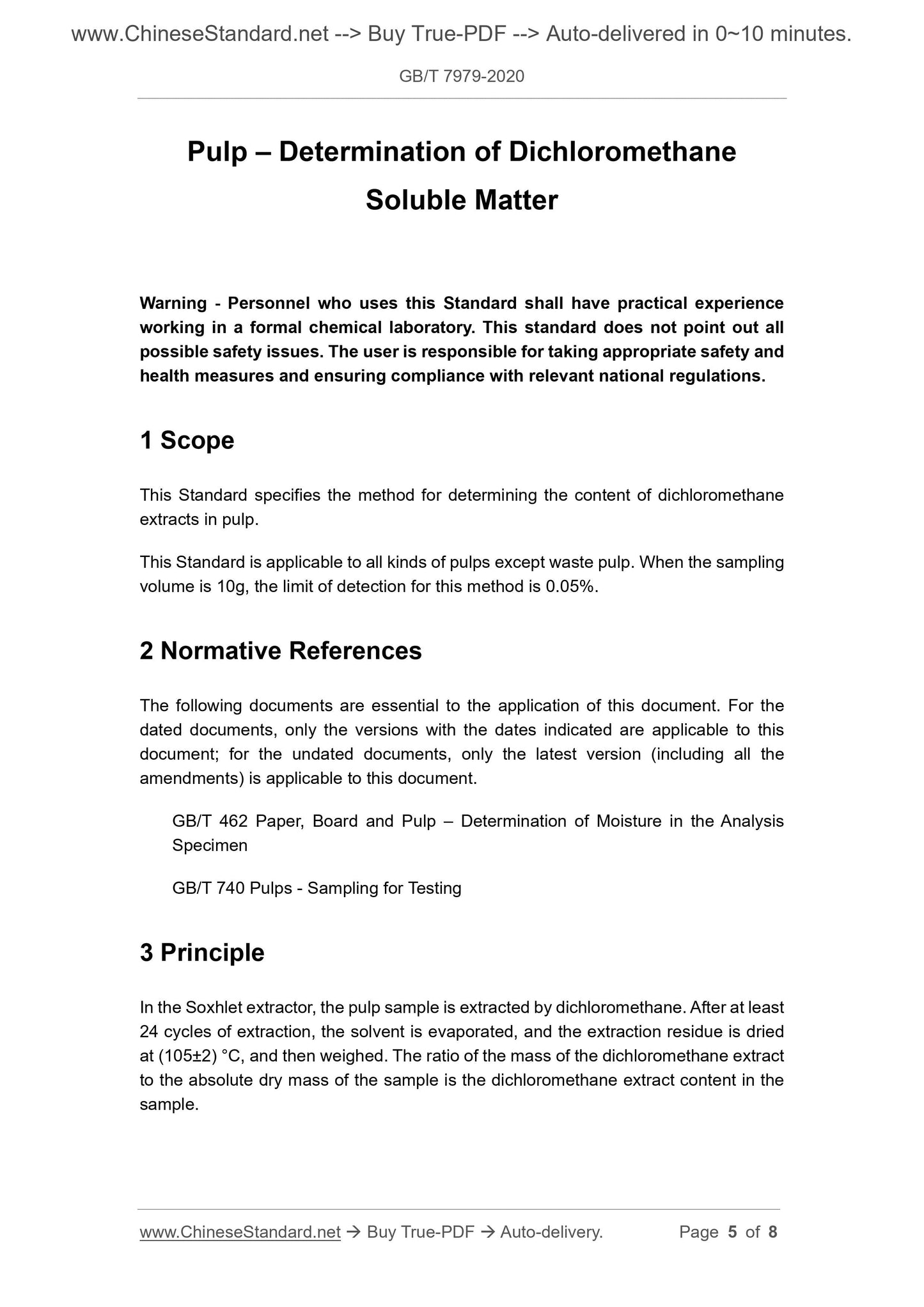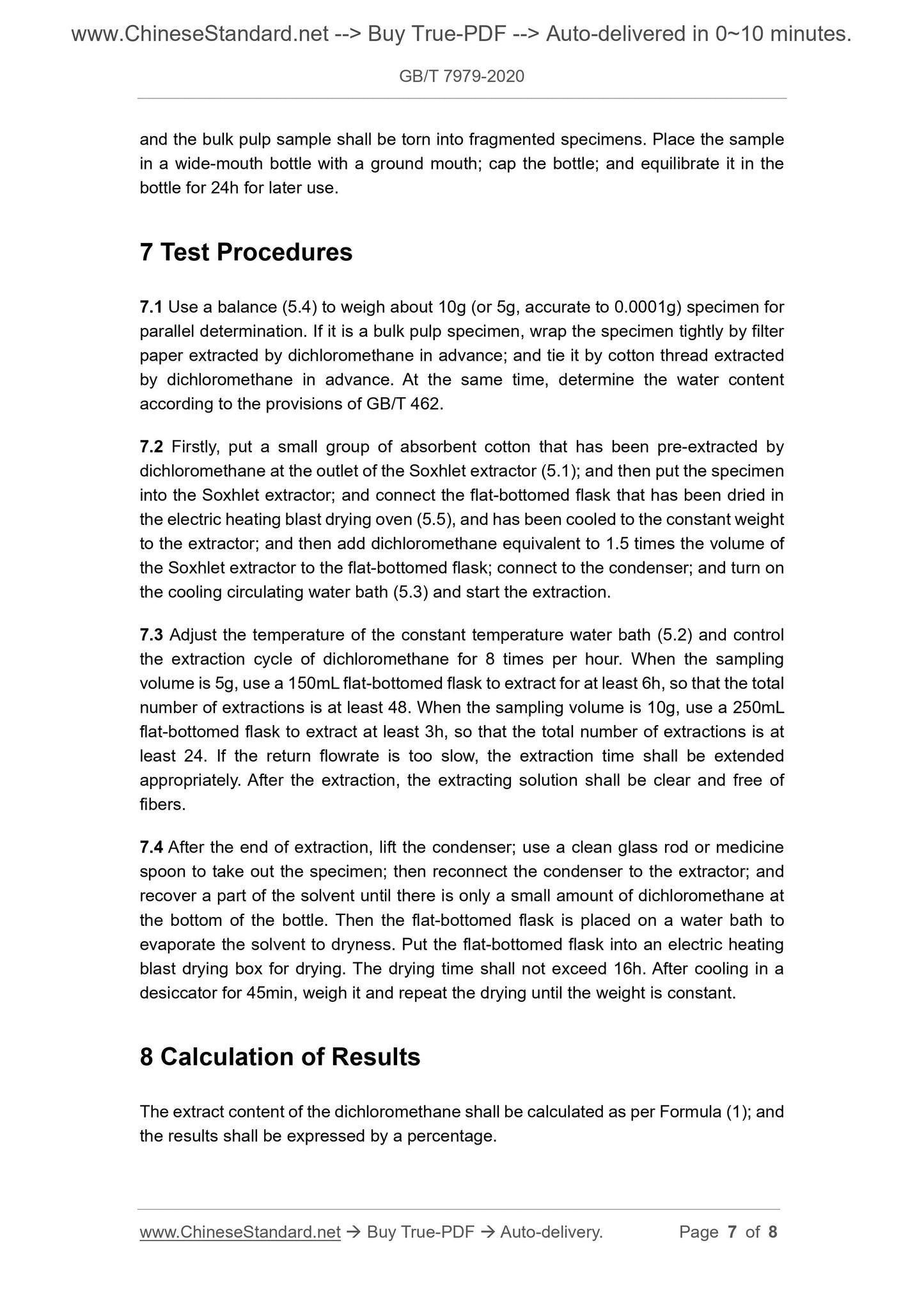1
/
de
4
PayPal, credit cards. Download editable-PDF and invoice in 1 second!
GB/T 7979-2020 English PDF (GBT7979-2020)
GB/T 7979-2020 English PDF (GBT7979-2020)
Prix habituel
$110.00 USD
Prix habituel
Prix promotionnel
$110.00 USD
Prix unitaire
/
par
Frais d'expédition calculés à l'étape de paiement.
Impossible de charger la disponibilité du service de retrait
Delivery: 3 seconds. Download true-PDF + Invoice.
Get QUOTATION in 1-minute: Click GB/T 7979-2020
Historical versions: GB/T 7979-2020
Preview True-PDF (Reload/Scroll if blank)
GB/T 7979-2020: Pulp--Determination of dichloromethane soluble matter
GB/T 7979-2020
GB
NATIONAL STANDARD OF THE
PEOPLE’S REPUBLIC OF CHINA
ICS 85.040
Y 30
Replacing GB/T 7979-2005
Pulp – Determination of Dichloromethane
Soluble Matter
ISSUED ON: JULY 21, 2020
IMPLEMENTED ON: FEBRUARY 01, 2021
Issued by: State Administration for Market Regulation;
Standardization Administration of PRC.
Table of Contents
Foreword ... 3
1 Scope ... 5
2 Normative References ... 5
3 Principle ... 5
4 Reagents ... 6
5 Apparatus ... 6
6 Sample Preparation ... 6
7 Test Procedures ... 7
8 Calculation of Results ... 7
9 Report ... 8
Pulp – Determination of Dichloromethane
Soluble Matter
Warning - Personnel who uses this Standard shall have practical experience
working in a formal chemical laboratory. This standard does not point out all
possible safety issues. The user is responsible for taking appropriate safety and
health measures and ensuring compliance with relevant national regulations.
1 Scope
This Standard specifies the method for determining the content of dichloromethane
extracts in pulp.
This Standard is applicable to all kinds of pulps except waste pulp. When the sampling
volume is 10g, the limit of detection for this method is 0.05%.
2 Normative References
The following documents are essential to the application of this document. For the
dated documents, only the versions with the dates indicated are applicable to this
document; for the undated documents, only the latest version (including all the
amendments) is applicable to this document.
GB/T 462 Paper, Board and Pulp – Determination of Moisture in the Analysis
Specimen
GB/T 740 Pulps - Sampling for Testing
3 Principle
In the Soxhlet extractor, the pulp sample is extracted by dichloromethane. After at least
24 cycles of extraction, the solvent is evaporated, and the extraction residue is dried
at (105±2) °C, and then weighed. The ratio of the mass of the dichloromethane extract
to the absolute dry mass of the sample is the dichloromethane extract content in the
sample.
and the bulk pulp sample shall be torn into fragmented specimens. Place the sample
in a wide-mouth bottle with a ground mouth; cap the bottle; and equilibrate it in the
bottle for 24h for later use.
7 Test Procedures
7.1 Use a balance (5.4) to weigh about 10g (or 5g, accurate to 0.0001g) specimen for
parallel determination. If it is a bulk pulp specimen, wrap the specimen tightly by filter
paper extracted by dichloromethane in advance; and tie it by cotton thread extracted
by dichloromethane in advance. At the same time, determine the water content
according to the provisions of GB/T 462.
7.2 Firstly, put a small group of absorbent cotton that has been pre-extracted by
dichloromethane at the outlet of the Soxhlet extractor (5.1); and then put the specimen
into the Soxhlet extractor; and connect the flat-bottomed flask that has been dried in
the electric heating blast drying oven (5.5), and has been cooled to the constant weight
to the extractor; and then add dichloromethane equivalent to 1.5 times the volume of
the Soxhlet extractor to the flat-bottomed flask; connect to the condenser; and turn on
the cooling circulating water bath (5.3) and start the extraction.
7.3 Adjust the temperature of the constant temperature water bath (5.2) and control
the extraction cycle of dichloromethane for 8 times per hour. When the sampling
volume is 5g, use a 150mL flat-bottomed flask to extract for at least 6h, so that the total
number of extractions is at least 48. When the sampling volume is 10g, use a 250mL
flat-bottomed flask to extract at least 3h, so that the total number of extractions is at
least 24. If the return flowrate is too slow, the extraction time shall be extended
appropriately. After the extraction, the extracting solution shall be clear and free of
fibers.
7.4 After the end of extraction, lift the condenser; use a clean glass rod or medicine
spoon to take out the specimen; then reconnect the condenser to the extractor; and
recover a part of the solvent until there is only a small amount of dichloromethane at
the bottom of the bottle. Then the flat-bottomed flask is placed on a water bath to
evaporate the solvent to dryness. Put the flat-bottomed flask into an electric heating
blast drying box for drying. The drying time shall not exceed 16h. After cooling in a
desiccator for 45min, weigh it and repeat the drying until the weight is constant.
8 Calculation of Results
The extract content of the dichloromethane shall be calculated as per Formula (1); and
the results shall be expressed by a percentage.
Get QUOTATION in 1-minute: Click GB/T 7979-2020
Historical versions: GB/T 7979-2020
Preview True-PDF (Reload/Scroll if blank)
GB/T 7979-2020: Pulp--Determination of dichloromethane soluble matter
GB/T 7979-2020
GB
NATIONAL STANDARD OF THE
PEOPLE’S REPUBLIC OF CHINA
ICS 85.040
Y 30
Replacing GB/T 7979-2005
Pulp – Determination of Dichloromethane
Soluble Matter
ISSUED ON: JULY 21, 2020
IMPLEMENTED ON: FEBRUARY 01, 2021
Issued by: State Administration for Market Regulation;
Standardization Administration of PRC.
Table of Contents
Foreword ... 3
1 Scope ... 5
2 Normative References ... 5
3 Principle ... 5
4 Reagents ... 6
5 Apparatus ... 6
6 Sample Preparation ... 6
7 Test Procedures ... 7
8 Calculation of Results ... 7
9 Report ... 8
Pulp – Determination of Dichloromethane
Soluble Matter
Warning - Personnel who uses this Standard shall have practical experience
working in a formal chemical laboratory. This standard does not point out all
possible safety issues. The user is responsible for taking appropriate safety and
health measures and ensuring compliance with relevant national regulations.
1 Scope
This Standard specifies the method for determining the content of dichloromethane
extracts in pulp.
This Standard is applicable to all kinds of pulps except waste pulp. When the sampling
volume is 10g, the limit of detection for this method is 0.05%.
2 Normative References
The following documents are essential to the application of this document. For the
dated documents, only the versions with the dates indicated are applicable to this
document; for the undated documents, only the latest version (including all the
amendments) is applicable to this document.
GB/T 462 Paper, Board and Pulp – Determination of Moisture in the Analysis
Specimen
GB/T 740 Pulps - Sampling for Testing
3 Principle
In the Soxhlet extractor, the pulp sample is extracted by dichloromethane. After at least
24 cycles of extraction, the solvent is evaporated, and the extraction residue is dried
at (105±2) °C, and then weighed. The ratio of the mass of the dichloromethane extract
to the absolute dry mass of the sample is the dichloromethane extract content in the
sample.
and the bulk pulp sample shall be torn into fragmented specimens. Place the sample
in a wide-mouth bottle with a ground mouth; cap the bottle; and equilibrate it in the
bottle for 24h for later use.
7 Test Procedures
7.1 Use a balance (5.4) to weigh about 10g (or 5g, accurate to 0.0001g) specimen for
parallel determination. If it is a bulk pulp specimen, wrap the specimen tightly by filter
paper extracted by dichloromethane in advance; and tie it by cotton thread extracted
by dichloromethane in advance. At the same time, determine the water content
according to the provisions of GB/T 462.
7.2 Firstly, put a small group of absorbent cotton that has been pre-extracted by
dichloromethane at the outlet of the Soxhlet extractor (5.1); and then put the specimen
into the Soxhlet extractor; and connect the flat-bottomed flask that has been dried in
the electric heating blast drying oven (5.5), and has been cooled to the constant weight
to the extractor; and then add dichloromethane equivalent to 1.5 times the volume of
the Soxhlet extractor to the flat-bottomed flask; connect to the condenser; and turn on
the cooling circulating water bath (5.3) and start the extraction.
7.3 Adjust the temperature of the constant temperature water bath (5.2) and control
the extraction cycle of dichloromethane for 8 times per hour. When the sampling
volume is 5g, use a 150mL flat-bottomed flask to extract for at least 6h, so that the total
number of extractions is at least 48. When the sampling volume is 10g, use a 250mL
flat-bottomed flask to extract at least 3h, so that the total number of extractions is at
least 24. If the return flowrate is too slow, the extraction time shall be extended
appropriately. After the extraction, the extracting solution shall be clear and free of
fibers.
7.4 After the end of extraction, lift the condenser; use a clean glass rod or medicine
spoon to take out the specimen; then reconnect the condenser to the extractor; and
recover a part of the solvent until there is only a small amount of dichloromethane at
the bottom of the bottle. Then the flat-bottomed flask is placed on a water bath to
evaporate the solvent to dryness. Put the flat-bottomed flask into an electric heating
blast drying box for drying. The drying time shall not exceed 16h. After cooling in a
desiccator for 45min, weigh it and repeat the drying until the weight is constant.
8 Calculation of Results
The extract content of the dichloromethane shall be calculated as per Formula (1); and
the results shall be expressed by a percentage.
Share








